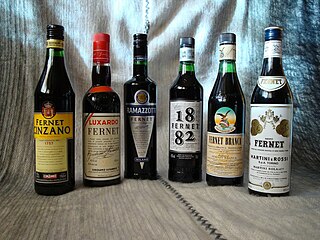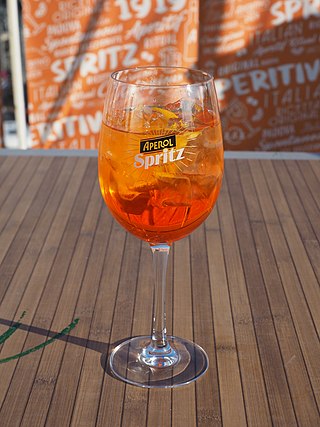Calisaya is a herbal liqueur produced by infusing cinchona calisaya, and other barks, roots and flowers in grain neutral spirit and Seville orange extract. [1] It is a contemporary revision of the classic Italian amaro. [2] It is handcrafted in small numbered batches by Elixir, Inc., a craft distillery in Eugene, Oregon, [3] which was founded by the Italian brothers Andrea and Mario Loreto.
It can be drunk as both an apéritif and digestif or used as a bitter ingredient in cocktails.
Cinchona based liqueurs are very popular in Italy under the generic name of China (pronounced Kee-nah), the Italian name of cinchona. They also were popular in the US before Prohibition, where calisaya was the generic name of any cinchona based liqueur or bitters and was used as an ingredient or bitter in several cocktail recipes. After Prohibition, calisaya liqueurs disappeared from the US market until Elixir, Inc. reconstructed the liqueur and trademarked the name Calisaya.

A cocktail is a mixed drink, usually alcoholic. Most commonly, a cocktail is a combination of one or more spirits mixed with other ingredients, such as juices, flavored syrups, tonic water, shrubs, and bitters. Cocktails vary widely across regions of the world, and many websites publish both original recipes and their own interpretations of older and more famous cocktails.

A Manhattan is a cocktail made with whiskey, sweet vermouth, and bitters. While rye is the traditional whiskey of choice, other commonly used whiskies include Canadian whisky, bourbon, blended whiskey, and Tennessee whiskey. The cocktail is usually stirred with ice then strained into a chilled cocktail glass and garnished traditionally with a maraschino cherry. A Manhattan may also be served on the rocks in a lowball glass.

Vermouth is an aromatized fortified wine, flavoured with various botanicals and sometimes colored. The modern versions of the beverage were first produced in the mid to late 18th century in Turin, Italy. While vermouth was traditionally used for medicinal purposes, it was later served as an apéritif, with fashionable cafés in Turin serving it to guests around the clock. In the late 19th century, it became popular with bartenders as a key ingredient for cocktails, such as the martini, the Manhattan, the Rob Roy, and the Negroni. In addition to being consumed as an aperitif or cocktail ingredient, vermouth is sometimes used as an alternative to white wine in cooking.

A margarita is a cocktail consisting of tequila, triple sec, and lime juice. Some margarita recipes include simple syrup as well and are often served with salt on the rim of the glass. Margaritas can be served either shaken with ice, without ice, or blended with ice. Most bars serve margaritas in a stepped-diameter variant of a cocktail glass or champagne coupe called a margarita glass. The margarita is one of the world's most popular cocktails and the most popular tequila-based cocktail.

Anisette, or Anis, is an anise-flavored liqueur that is consumed in most Mediterranean countries. It is colorless and, because it contains sugar, is sweeter than dry anise flavoured spirits. The most traditional style of anisette is that produced by means of distilling aniseed, and is differentiated from those produced by simple maceration by the inclusion of the word distilled on the label. And while Pastis is a similar-tasting liqueur that is prepared in similar fashion and sometimes confused with anisette, it employs a combination of both aniseed and licorice root extracts. Sambuca is essentially an anisette of Italian origin that requires a high minimum (350g/L) sugar content.

A bitters is traditionally an alcoholic preparation flavored with botanical matter for a bitter or bittersweet flavor. Originally, numerous longstanding brands of bitters were developed as patent medicines, but now are sold as digestifs, sometimes with herbal properties, and as cocktail flavorings.

Chartreuse is a French herbal liqueur available in green and yellow versions that differ in taste and alcohol content. The liqueur has been made by Carthusian monks since 1737 according to instructions set out in a manuscript given to them by François Annibal d'Estrées in 1605. It was named after the monks' Grande Chartreuse monastery, located in the Chartreuse Mountains north of Grenoble. Today the liqueur is produced in their distillery in nearby Aiguenoire. It is composed of distilled alcohol aged with 130 herbs, plants and flowers.

Amaretto is a sweet Italian liqueur originating from the comune (municipality) of Saronno. Depending on the brand, it may be made from apricot kernels, bitter almonds, peach stones, or almonds, all of which are natural sources of the benzaldehyde that provides the almond-like flavour of the liqueur. It generally contains 21 to 28 percent alcohol by volume.

Becherovka, formerly Karlsbader Becherbitter, is a herbal bitters, often drunk as a digestif. It is produced in Karlovy Vary, Czech Republic by the Jan Becher company. The brand is owned by Pernod Ricard. It is made from a secret recipe based on more than twenty types of herbs and spices.

Tia Maria is a dark coffee liqueur made in Italy using Jamaican coffee beans. The main ingredients are coffee beans, Jamaican rum, vanilla, and sugar, blended to an alcoholic content of 20%.
Crème de violette and liqueur de violette are generic terms for a liqueur with natural and/or artificial violet flower flavoring and coloring with either a brandy base, a neutral spirit base, or a combination of the two. The taste profile and aroma are distinctly floral and sweet, and reminiscent of the violet candies popular in the early to mid 20th century. Its known production dates back to the early 19th century when it was served with dry vermouth or alone as a cordial.

Fernet is an Italian type of amaro, a bitter, aromatic spirit. Fernet is made from a number of herbs and spices which vary according to the brand, but usually include myrrh, rhubarb, chamomile, cardamom, aloe, and especially saffron, with a base of distilled grape spirits.

Licor 43, or Cuarenta y Tres, is a Spanish liqueur, made in Cartagena, Spain.

Lillet is a French wine–based aperitif from Podensac. Classed as an aromatised wine within EU law, it is a blend of 85% Bordeaux region wines and 15% macerated liqueurs, mostly citrus liqueurs. The mix is then stirred in oak vats until blended. During the aging process, Lillet is handled as a Bordeaux wine.

Aperol is an Italian bitter apéritif made with gentian, rhubarb, and cinchona, among other ingredients. It has a vibrant orange hue. Its name comes from apero, a French slang word for 'apéritif'.

Amaro is an Italian herbal liqueur that is commonly consumed as an after-dinner digestif. It usually has a bitter-sweet flavour, sometimes syrupy, and has an alcohol content between 16% and 40%.

A spritz is an Italian wine-based cocktail, commonly served as an apéritif across Italy. It consists of Prosecco, digestive bitters and soda water. The original spritz veneziano uses Select as bitters and was created in Venice in 1920. Popular variants are spritz al Campari, which uses Campari, and Aperol spritz, which uses Aperol as bitters.

Fernet-Branca is an Italian brand of fernet, a style of amaro or bitters. It was formulated in Milan in 1845, and is manufactured there by Fratelli Branca Distillerie.

Italicus Rosolio di Bergamotto is a bergamot rosolio manufactured in Italy. The liqueur uses bergamot from Calabria and citrons from Sicily, along with Italian flower varieties. Italicus was created by an Italian bartender, Giuseppe Gallo, using a family recipe. He launched the spirit commercially in September 2016.